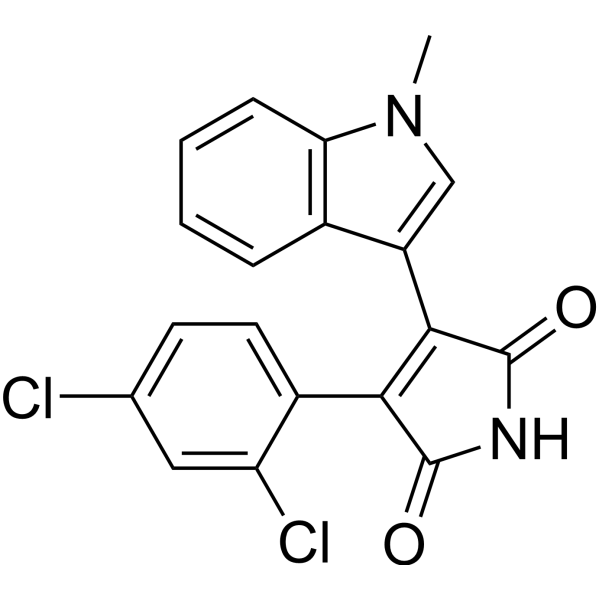Home
Products
SB216763



| Product Name | SB216763 |
| Price: | Inquiry |
| Catalog No.: | CN00425 |
| CAS No.: | 280744-09-4 |
| Molecular Formula: | C19H12N2O2Cl2 |
| Molecular Weight: | 371.22 g/mol |
| Purity: | >=98% |
| Type of Compound: | Alkaloids |
| Physical Desc.: | Powder |
| Source: | |
| Solvent: | Chloroform, Dichloromethane, Ethyl Acetate, DMSO, Acetone, etc. |
| SMILES: | Clc1ccc(c(c1)Cl)C1=C(C(=O)NC1=O)c1cn(c2c1cccc2)C |
| Contact us | |
|---|---|
| First Name: | |
| Last Name: | |
| E-mail: | |
| Question: | |
| Description | SB 216763 is potent, selective and ATP-competitive GSK-3 inhibitor with IC50s of 34.3 nM for both GSK-3α and GSK-3β. |
| Target | GSK-3α:34.3 nM (IC50) GSK-3β:34.3 nM (IC50) |
| In Vitro | SB-216763 (10-20 µM) induces β-catenin mediated-transcription in a dose-dependent manner in HEK293 cells. SB-216763 (10, 15 and 20 µM) can maintain mESCs with a pluripotent-like morphology in long-term culture. SB-216763 (10 µM) can maintain J1 mESCs in a pluripotent state for more than a month[2]. SB-216763 inhibits GSK-3 with IC50 of 34 nM[3]. SB-216763 is equally effective at inhibiting human GSK-3α and GSK-3β[5]. |
| In Vivo | SB216763 (20 mg/kg, i.v.) significantly improves the survival of BLM-treated mice. Mice randomized to receive BLM plus SB216763 shows a noteworthy reduction, compared with BLM-treated mice. SB216763 (20 mg/kg, i.v.) reduces the magnitude of BLM-induced alveolitis[1]. SB 216763 (0.2 mg/kg, i.v.) with either 17β-E100 or Geni100 reverses the ceiling effect because these agents significantly reduce infarct size when the rabbits' hearts are submitted to 30-min CAO[4]. |
| Cell Assay | MESCs maintained with LIF or 10 µM SB-216763 for more than a month are resuspended at 40,000 cells/mL in LIF-free mESC medium. EBs are prepared by a hanging drop procedure. Briefly, 20 µL drops containing mESCs are pipetted on the inside of a 10-cm Petri dish lid. The lids are placed onto Petri dishes containing 10 mL of HBSS and the EBs are allowed to form and grow for 4 days in the incubator. After 4 days, 15-20 EBs are transferred to a well containing LIF-free mESC medium in a 24-well plate. The medium is exchanged every two days and autonomously beating cell aggregates are observed and counted. |
| Animal Admin | Mice are allocated to four groups (n=12/group) as follows: 1) intratracheal saline + vehicle (25% dimethyl sulfoxide, 25% polyethylene glycol, and 50% saline), 2) intratracheal saline + SB216763 (20 mg/kg) dissolved in vehicle, 3) intratracheal BLM (3 U/kg) + vehicle, and 4) intratracheal BLM + SB216763 (20 mg/kg) in vehicle. Another set of experiments to assess cytokine expression by reverse transcription-PCR is conducted in the mice (n=12/group) to receive 1) intratracheal saline + vehicle, 2) intratracheal BLM, and 3) intratracheal BLM + SB216763. To induce pulmonary fibrosis, BLM is intratracheally administered in mice (n=15/group) on day 0. BLM and saline-treated mice are administered with SB216763 dissolved in vehicle or vehicle alone intravenously at day 0 and then intraperitoneally twice a week until day 28. Mice are sacrificed by CO2 inhalation on days 2, 7, and 28. In the terminal deoxynucleotidyl transferase dUTP nick-end labeling (TUNEL) experiments, the cohorts of mice are as follows: saline-treated (n=6), BLM-treated (n=6), and BLM + SB216763-treated (n=6). |
| Density | 1.5±0.1 g/cm3 |
| Boiling Point | 598.1±50.0 °C at 760 mmHg |
| Flash Point | 315.5±30.1 °C |
| Exact Mass | 370.027588 |
| PSA | 51.10000 |
| LogP | 4.79 |
| Vapour Pressure | 0.0±1.7 mmHg at 25°C |
| Storage condition | −20°C |